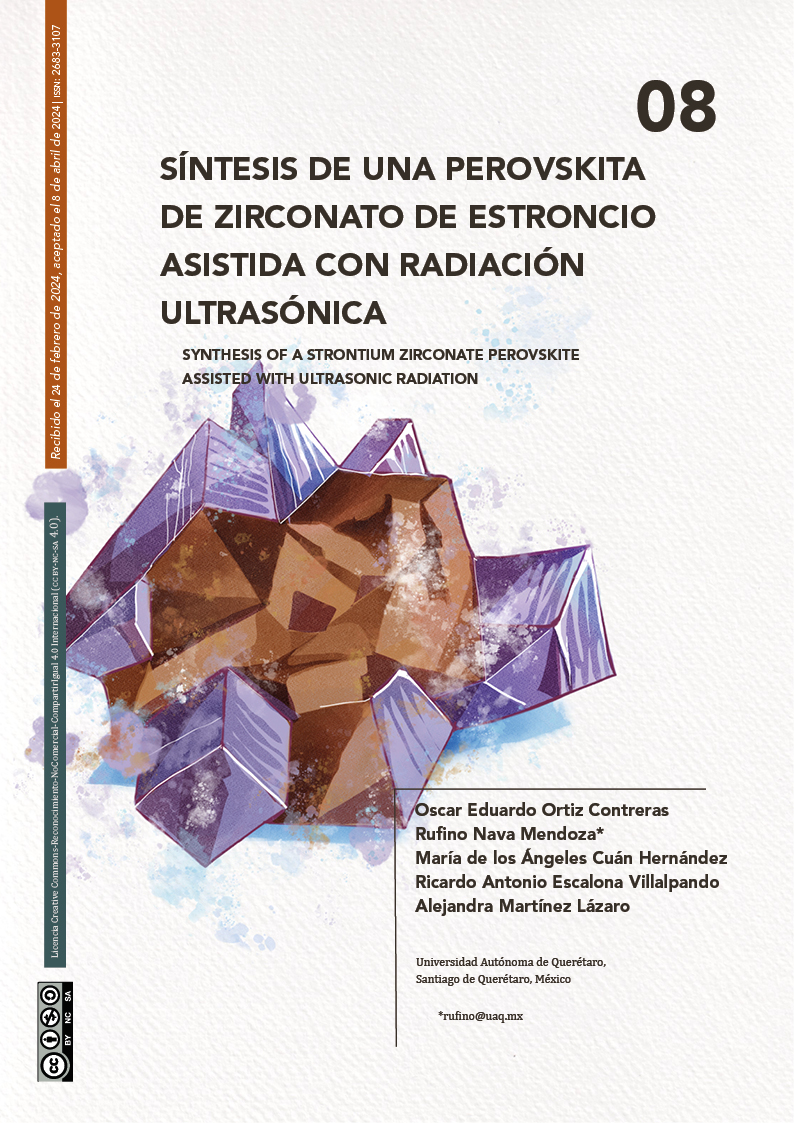Abstract
Zirconate-based perovskites are materials with great potential in the field of photocatalysis due to their excellent electronic, optical, and catalytic properties. The absence of photoresponse to visible light and high percentage of charge carrier recombination make it far from optimal, leading to low yields in reactions like the hydrogen evolution one. Strontium zirconate perovskite-type materials, doped with copper and assisted by ultrasonic radiation were synthesized by the sol-gel method, for their possible application in hydrogen reduction. The structural, electronic, optical, and electrochemical properties were evaluated through X-ray diffraction (XRD), diffuse reflectance spectroscopy (DRS), and electrochemical characterization. The results strongly suggested that the best candidate for the application in HER is Cu0.03Sr0.97ZrO3 SQ, since both copper and the application of ultrasonic radiation generate changes in lattice parameters, type of band gap semiconductor (from indirect to direct), light absorption percentage, and finally, the reduction potential and current density of the catalyst.
References
S. Ezendam et al., "Hybrid Plasmonic Nanomaterials for Hydrogen Generation and Carbon Dioxide Reduction", ACS Energy Lett., vol. 7, n.o 2, pp. 778-815, feb. 2022.
R. Marschall, "50 Years of Materials Research for Photocatalytic Water Splitting", Eur. J. Inorg. Chem., vol. 2021, n.o 25, pp. 2435-2441, jul. 2021.
S. Luo, X. Ren, H. Lin, H. Song, y J. Ye, "Plasmonic photothermal catalysis for solar-to-fuel conversion: current status and prospects", Chem. Sci., vol. 12, n.o 16, pp. 5701-5719, 2021.
S. C. Shit, I. Shown, R. Paul, K.-H. Chen, J. Mondal, y L.-C. Chen, "Integrated nano-architectured photocatalysts for photochemical CO2 reduction", Nanoscale, vol. 12, n.o 46, pp. 23301-23332, 2020.
C. Wang, Z. Sun, Y. Zheng, y Y. H. Hu, "Recent progress in visible light photocatalytic conversion of carbon dioxide", J. Mater. Chem. A, vol. 7, n.o 3, pp. 865-887, 2019.
J. H. Kim, D. Hansora, P. Sharma, J.-W. Jang, y J. S. Lee, "Toward practical solar hydrogen production – an artificial photosynthetic leaf-to-farm challenge", Chem. Soc. Rev., vol. 48, n.o 7, pp. 1908-1971, 2019.
M. Irshad et al., "Photocatalysis and perovskite oxide-based materials: a remedy for a clean and sustainable future", RSC Adv., vol. 12, n.o 12, pp. 7009-7039, 2022.
A. M. Huerta-Flores et al., "Enhanced Photocatalytic Hydrogen Evolution from Water Splitting on Ta2O5/SrZrO3 Heterostructures Decorated with CuxO/RuO2 Cocatalysts", ACS Appl. Mater. Interfaces, vol. 14, n.o 28, pp. 31767-31781, jul. 2022.
Z. Guo, B. Sa, B. Pathak, J. Zhou, R. Ahuja, y Z. Sun, "Band gap engineering in huge-gap semiconductor SrZrO3 for visible-light photocatalysis", International Journal of Hydrogen Energy, vol. 39, n.o 5, pp. 2042-2048, feb. 2014.
J. Zhu, G. Cheng, J. Xiong, W. Li, y S. Dou, "Recent Advances in Cu‐Based Cocatalysts toward Solar‐to‐Hydrogen Evolution: Categories and Roles", Sol. RRL, vol. 3, n.o 10, p. 1900256, oct. 2019.
B. Himabindu, N. S. M. P. Latha Devi, y B. Rajini Kanth, "Microstructural parameters from X-ray peak profile analysis by Williamson-Hall models; A review", Materials Today: Proceedings, vol. 47, pp. 4891-4896, 2021.
S. Landi, I. R. Segundo, E. Freitas, M. Vasilevskiy, J. Carneiro, y C. J. Tavares, "Use and misuse of the Kubelka-Munk function to obtain the band gap energy from diffuse reflectance measurements", Solid State Communications, vol. 341, p. 114573, ene. 2022.

This work is licensed under a Creative Commons Attribution-NonCommercial-ShareAlike 4.0 International License.
Copyright (c) 2024 Perspectivas de la Ciencia y la Tecnología

